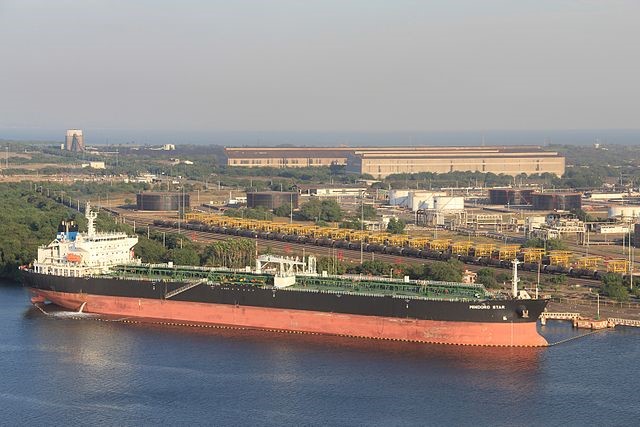How does strategic competition between the United States and China influence the evolution of transnational organised crime in Latin America and the Caribbean (LAC)? Although it is becoming increasingly visible, the “global power competition – transnational organised crime’ nexus remains unexplored in national and international scholarship as well as in risk assessments and, therefore, in the policy-making process.
The purpose of this article is to examine this global power competition and transnational organised crime nexus. I argue that strategic competition between the United States and China feeds – unintentionally or otherwise – dynamics associated with organised crime in LAC, thus having implications for democratic governance, citizen security, and sustainable development in the region. This article focuses the criminal organisation known as the Knights Templar, analysing its infiltration and exploitation of iron ore in Michoacán and their interaction with Chinese brokers in the mining industry. Information was gathered from discussions with government officials and scholars, interviewed in 2019, as well as open-source analysis.
Latin America Amid Geopolitical Transition
Over the last 30 years, security dynamics in Latin America have been conditioned by “comorbidities” driven by social unrest, political upheaval, and the operation of violent non-state actors. The main effects of which have traditionally manifested in crime, political violence, conflict over natural resources, urban violence, the use of the armed forces for public security tasks, and a democratic recession.
Now, Latin America has become a geopolitical chessboard for great power competition, a development that poses new challenges to both regional and hemispheric security and defence. The confluence of both old and new threats may be exacerbating pre-existing comorbidities in Latin American countries – chief among them, transnational organised crime.
The Knights Templar and Illicit Economies
In 2013, Michoacán underwent a severe crisis of armed violence and social unrest following the emergence of several self-defence groups across the embattled southwestern Mexican state. At the time, some analysts warned of the outbreak of a civil war. The Knights Templar fought to remain as the hegemonic criminal organisation in the region. Any failure or perceived weakness would’ve meant the loss of large amounts of money not only from drug trafficking, but from profitable revenue streams associated with the exploitation of natural resources from Michoacán’s arable lands, forests, mineral deposits and coastal. The Knights Templar thus created, maintained, and benefited from a range of illicit economies based on drugs, cattle, avocados, lemons, timber and iron ore. In fact, federal authorities at that time claimed that the Knights Templar’s exploitation of iron ore became the main source of revenue for the organisation – even above the sale of methamphetamines.
The control that the Knights Templar exerted over the extraction of iron ore cannot be understood without considering the international dimension of this illicit economy. According to public security officials, the control of the Knights Templar in the port city of Lázaro Cárdenas in Michoacán, did not at all impede Chinese mining brokerages and export companies from operating in the port. A senior-level government official noted that the link between the Knights Templar and Chinese export companies was critical to understanding the addition of iron ore mining to the criminal group’s portfolio of economic activities.
According to another source working for the federal government at that time, the Knights Templar sold approximately 4 million tons of iron ore to Chinese intermediaries through January and October of 2013. In other words, at least 52% of Michoacán’s iron ore production was exported illegally through – since the state produced 7.6 million tons that year, according to figures from the Mexican Geological Service (SGM). Furthermore, an expert in organised crime in Michoacán, who accepted to be interviewed under condition of anonymity, maintained that the Knights Templar sold the iron ore at a profit of $15 per ton. This figure would generate an annual revenue of approximately $60 million dollars for the cartel, a profit higher than the $40 million figure estimated by journalists Santiago Pérez and José de Córdoba. According to Pérez y Córdoba, in some cases Chinese companies did not pay cash for the illegally extracted iron ore. Instead, they provided chemical precursors to the Knights Templar.
This quid pro quo relationship benefited the criminal organisation enormously. The alleged deal allowed the Knights Templar to retain or increase control over the production process of iron ore in Michoacán, while still maintaining its presence and control over methamphetamine markets, both in Mexico and the United States.
Great Power Competition Nexus
It is worth asking whether those Chinese intermediaries were acting independently of Beijing and its larger geostrategic interests in the Western Hemisphere. After all, it should be noted, China is the world’s leading manufacturer and exporter of steel – made from iron ore. Through the period 2008–2012, China increased its annual steel production from 512 to 717 million tons. The sheer size and dynamism of the Chinese steel industry has allowed it to maintain the high degree of industrialisation necessary to continue its long term strategic project.
This article is in no way intended to criminalise a single government or country altogether – in this case China. Rather, this case study suggests that recent trends in changing and duelling global competition – particularly for strategically important resources – have given rise to new criminogenic opportunities. As for Latin America and the Caribbean, this strategic competition aimed at securing the supply chains of natural resources and environmental commodities presents a particularly acute threat due to the existence of strategic natural resources and the presence of violent non-state actors – among which organised crime groups stand out. With new players, incentives and profits to be made, the by-product of the competition may be new golden era for violent non-state actors in the Western Hemisphere.
Final Remarks
This article focused on a case study of the potential impact that global strategic competition may have had on strengthening and enriching an organised criminal group. Whether it be the Knights Templar benefiting through exploitation of iron ore in Lázaro Cárdenas, Michoacán or another group, it is imperative to bring back the geopolitical component to the analysis of transnational organised crime and criminal violence in LAC countries. In turn, this added analytic lens should be followed by the design and implementation of policies aimed at addressing this phenomenon. If not, the ‘global power competition – transnational organised crime’ nexus may well gradually deteriorate democratic governance, citizen security and sustainable development in an already volatile region.
Fausto Carbajal-Glass is founder of Delphi Solutions and Strategic Services, a boutique research, education, and consultancy firm on political risk and security. Coordinator of the Law Enforcement, Security Cooperation and Transnational Organised Crime Study Unit at the Mexican Council of Foreign Relations (COMEXI).
Main Image Credit: Puerto Lazaro Cardenas, via Wikicommons.
The views expressed in this article are those of the authors and do not necessarily reflect the views of RUSI or any other institution.



